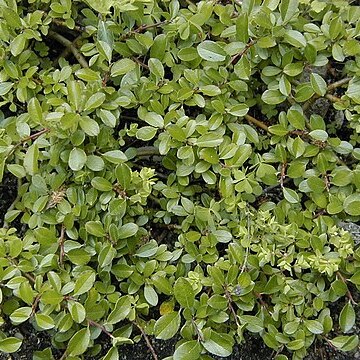Plants 0.01-0.05 m, (dwarf), forming clonal compact mats by layering. Stems prostrate, short-trailing; branches red-brown, gray-brown, or yellow-brown, glabrous; branchlets yellow-green or yellow-brown, glabrous or puberulent. Leaves: stipules (sometimes marcescent) absent, rudimentary, or foliaceous on early ones, foliaceous on late ones; petiole (shallowly to deeply grooved adaxially), 2-6.5 mm; largest medial blade (marcescent), amphistomatous or hypostomatous, ovate, broadly obovate, oblanceolate, or elliptic, 4-23 × 3.5-10 mm, 1.7-3.6 times as long as wide, base convex or cuneate, margins flat, serrulate or crenulate, apex convex, acuminate, acute, or retuse, abaxial surface glaucous, usually glabrous (rarely few hairs), adaxial slightly or highly glossy, usually glabrous (rarely a few hairs); proximal blade margins entire or serrate; juvenile blade glabrous, pilose, or puberulent abaxially. Catkins: staminate 9-19 × 5-8 mm, flowering branchlet 0.5-9 mm; pistillate densely flowered, slender to subglobose, 11-47(-55 in fruit) × 6-10 mm, flowering branchlet 2-10 mm; floral bract brown, black, tawny, light rose, or bicolor, 1.1-1.8 mm, apex rounded or acute, entire, abaxially sparsely hairy, hairs straight or wavy. Staminate flowers: abaxial nectary absent, adaxial nectary narrowly oblong or oblong, 0.4-0.9 mm; filaments distinct, glabrous; stamens usually 1, rarely 2; anthers ellipsoid or shortly cylindrical, 0.4-0.7 mm. Pistillate flowers: abaxial nectary absent, adaxial nectary narrowly oblong or oblong, 0.5-0.8 mm, shorter to longer than stipe; stipe 0.3-1.6 mm; ovary ovoid or pyriform, glabrous, beak gradually tapering to styles; ovules 4-9 per ovary; styles 0.4-1 mm; stigmas flat, abaxially non-papillate with rounded tip, or slenderly cylindrical, 0.1-0.23-0.4 mm. Capsules 3-5 mm. 2n = 38.
More
Prostrate, matted alpine shrub with stoutish, leafy, brown twigs; buds ovate, 1–2 mm, brown, glabrous, stipules mostly none; petioles 2–4 mm; lvs narrowly to broadly elliptic, or obovate, 5–20(–25) × 2–7(–10) mm, ± glandular-crenate, acute at base, green, shining, and reticulate above, glaucous and strongly reticulate beneath, glabrous or sometimes silky-villous when young, sometimes persistent and marcescent; catkins with or shortly after the lvs, 1–4 cm, on leafy peduncles 0.5–2 cm, scales brown with blackish tip, 1–1.5 mm, villous; stamen 1 (by cohesion) or rarely 2; staminate fls biglandular; frs more numerous than in no. 12 [Salix herbacea L.], conic, 3–4 mm, subsessile, glabrous; style 0.7–1.5 mm; 2n=38. Exposed, rocky places; Greenl. and Baffin Isl., s. to the mts. of Me., N.H. and N.Y. June–Aug.

